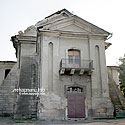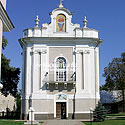Ukraine
Ivano-Frankivsk region
Kolomyja district
Horodenka
Worth seeing
Worth seeing in Horodenka
-
Armenian Church
The Armenian church was built in 1706. The interior of the church was famous for its richness and magnificence. The church was surrounded with the high stone wall, there was an Armenian cemetery inside. The construction of the complex was the evidence of the large influence of the Armenian community on the city's trade and commerce. Today the church is the oldest preserved architectural monument in the city that needs restoration.Address: Horodenka, Krushelnytsky St. 8 -
Church of Assumption
The church is a monument of the late baroque architecture. It was built in 1763 for the Greek-Catholic community of the city. Its sponsor was Mykola Pototsky. The author of the project was B. Meretyn, the well known architect of the time. The iconostasis of the church resembles that of the St. George Cathedral in Lviv. That's why J.-G. Pinzel is supposed to be its author.Address: Horodenka, T. Shevchenko St. 70 -
Church of St. Nicholas
The stone church of St. Nickolas was built in 1793 by the city Greek-Catholic community. It was constructed on the place of wooden one that had not been preserved. It is not large by size, and, traditionally, it consists of the vestibule, nave and sanctuary. Above the main entrance to the church there is a wall painting of St. Nicholas. Close to the fence near the central entrance there is a large stone arched belltower.Address: Horodenka, Shkilna St. 31 -
Church of the Immaculate Conception of the Bl. Virgin Mary
The church is a monument of the late Baroque style. It was built during 1745-1769 on the order of Mykola Pototsky by architect B. Meretyn and sculptor J.-G. Pinzel. The church is considered to be the first common work of two masters, one of the most prominent monuments of the late Baroque style in Galicia. The complex also includes the building of monastery cells and the column with the statue of St. Virgin.Address: Horodenka, V. Velyky St., 1 -
Synagogue
The Jewish community left the important trace in the history and culture of Horodenka city. Mykola Pototsky gave some privileges to it and granted a lot for a synagogue and a cemetery. Later Horodenka became a center of Hasidism, there were several temples here. Till nowadays only one — the Great synagogue of late XIX c. had been preserved. During World War II practically all Jewish community was destroyed. The memorial plaque was established on the wall of the former synagogue to remember about those events.Address: Horodenka, Rynkova St. 1

 Ukraine
Ukraine Poland
Poland Slovakia
Slovakia
 Українською
Українською








